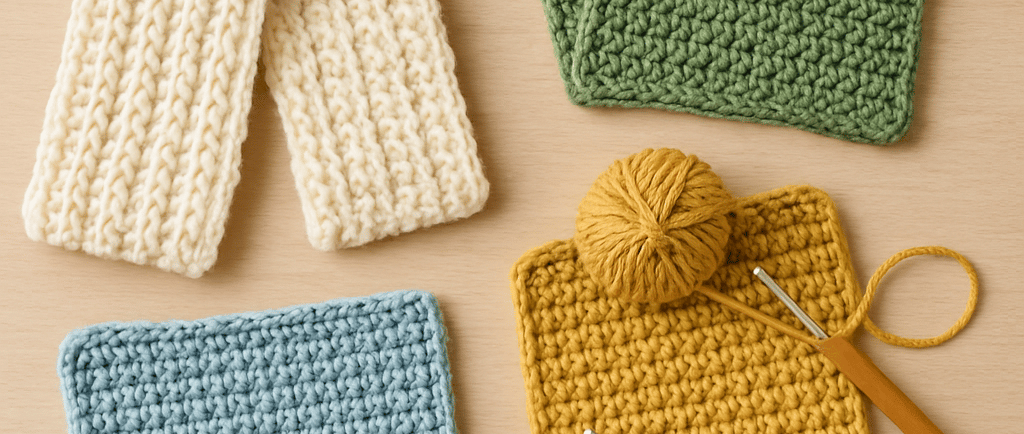Top 10 Crochet Tips for Beginners | Master Crochet
Unlock the joy of crochet with our beginner's guide. Master essential crochet tips, patterns, and stitches to create unique projects with confidence.
7/22/20254 min read


10 Essential Crochet Tips for Beginners
Crochet is a delightful craft that offers endless possibilities. It's perfect for creating beautiful and functional items.
For beginners, starting can feel overwhelming. But with the right guidance, you can master the basics quickly.
This guide will provide essential tips to help you begin your crochet journey. You'll learn about crochet patterns, stitches, and tools.
Understanding these fundamentals will boost your confidence and skills. Soon, you'll be crafting your own unique projects.
So grab your crochet hook and yarn. Let's dive into the world of crochet and discover the joy of creating with your hands.
1. Start with Simple Crochet Patterns
As a beginner, opt for simple crochet patterns to build confidence. Easy patterns help you grasp basic stitches and techniques without frustration.
Choose projects like dishcloths, scarves, or simple hats. These allow you to practice and perfect your skills.
Consider these beginner-friendly projects:
Dishcloths
Scarves
Simple hats
Starting with small, manageable projects helps you see progress quickly. This encourages you to continue developing your crochet abilities.
Learning to crochet should be a joyful experience, full of creativity and exploration. Soon, you'll be eager to tackle more complex designs.
2. Choose the Right Crochet Hooks and Yarn
Selecting the right crochet hooks and yarn is crucial. Different projects require specific tools for the best results.
Crochet hooks come in various materials like aluminum, bamboo, and plastic. Each material offers a different feel and weight.
Yarn choice affects your project's texture and appearance. Consider the yarn's weight, fiber, and color.
Remember these points when selecting materials:
Choose the appropriate hook size for your yarn
Consider the yarn's weight and fiber
Select hook material based on comfort
Experimenting with various hooks and yarns helps find what suits you. This enhances your overall crocheting experience.
3. Master Basic Crochet Stitches
Learning basic crochet stitches is the foundation of any crochet project. Start with the chain stitch, which forms the base of most patterns.
Once comfortable with chains, move on to single crochet stitches. These create firm, dense fabric that's perfect for many projects. Practice until you can maintain even stitches consistently.
Next, try the double crochet stitch. It's taller than single crochet, making it ideal for more textured designs. Remember to explore additional stitches as you grow more confident.
Here’s a list of essential stitches to start with:
Chain stitch
Single crochet
Double crochet
Mastering these basic stitches will prepare you for more complex patterns and techniques. With practice, you'll soon be crocheting with ease and precision.
4. Learn to Read Crochet Patterns and Abbreviations
Understanding crochet patterns and abbreviations is crucial for any beginner. Patterns often contain shorthand notations that describe the steps in a concise manner.
To get started, familiarize yourself with common crochet abbreviations. Abbreviations like "ch" for chain and "sc" for single crochet are frequently used in patterns. Knowing these will help you follow instructions more easily.
Here's a list of a few common abbreviations:
ch: Chain
sc: Single Crochet
dc: Double Crochet
As you practice reading patterns, you'll gain confidence in decoding them. Visual aids like charts can also be helpful for more complicated designs.
5. Practice Tension and Gauge
Perfecting tension control is key to making even stitches. Too tight, and your fabric may be stiff. Too loose, and it might lack structure.
Gauge refers to the number of stitches per inch. Checking gauge helps ensure your project matches the intended size. This is especially important for wearable items.
To practice, try making swatches with different tensions. Adjusting your hold on the yarn or using a different hook size can alter tension. Over time, this will lead to more consistent and professional-looking projects
6. Use Stitch Markers and Row Counters
Stitch markers are small tools that help you track your progress. They are especially useful in complex crochet patterns. Place them at the beginning of rounds or important stitch changes.
Row counters help keep a precise count in larger projects. This reduces mistakes and makes it easier to pause and continue without losing your place.
Use stitch markers in intricate designs
Employ row counters for long-term projects
Keep your markers organized for easy access
7. Keep Your Tools and Projects Organized
Keeping your crochet tools in order is key for smooth crafting. A chaotic workspace can hinder creativity. Utilize organizers to store your hooks, yarn, and other essentials.
Having a dedicated project bag is beneficial. It allows you to carry your crochet work with ease. Plus, it prevents tangles and keeps everything neat.
Use a crochet hook case
Store yarn by color or type
Keep a small notebook for pattern notes
8. Watch Crochet Tutorials and Join Communities
Learning crochet is much easier with visual aids. Online video tutorials offer step-by-step guidance on various techniques. They provide a chance to see each crochet stitch in action.
Joining online crochet communities can enhance your skills. These spaces allow beginners to connect and share experiences. The support and inspiration are invaluable for growth.
Find crochet channels on YouTube
Join crochet groups on social media
Participate in crochet forums and challenges
9. Learn to Fix Common Crochet Mistakes
Every beginner faces mistakes in crochet projects. It's part of the learning process. Understanding how to correct errors is crucial to improving.
Identifying the most common crochet mistakes can save time and frustration. Here are a few to watch for:
Missing or adding extra stitches
Inconsistent tension
Misreading patterns
With practice, fixing these issues becomes second nature. Gain confidence as you recognize and correct your crochet errors.
10. Enjoy the Process and Practice Regularly
Crochet is an art, not a race. Enjoy every loop and stitch. Relish the rhythm it brings.
Regular practice hones your skills and reduces stress. It allows creativity to flow freely. Set aside time to crochet consistently, fostering improvement and relaxation. Savor the satisfaction in creating something with your own hands. Each session is a step toward mastering this beautiful craft.
Conclusion: Your Crochet Journey Begins
Embarking on a crochet journey can be both rewarding and exciting. With these essential tips, you're well-prepared to delve into the art of crochet.
Remember, growth comes with each new project. Whether mastering crochet stitches or exploring patterns, embrace the process. Every piece you create tells a story of your progress. Enjoy the creative freedom and satisfaction your crochet journey offers. Happy crocheting!
